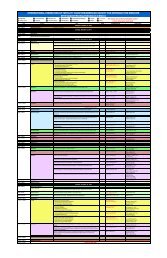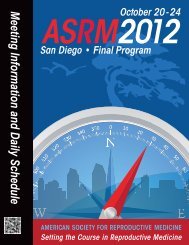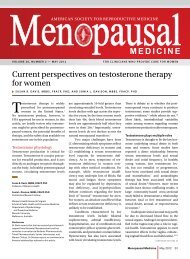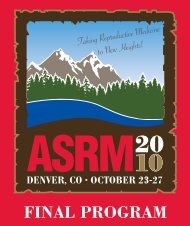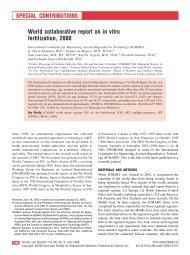scientific program • symposia - American Society for Reproductive ...
scientific program • symposia - American Society for Reproductive ...
scientific program • symposia - American Society for Reproductive ...
Create successful ePaper yourself
Turn your PDF publications into a flip-book with our unique Google optimized e-Paper software.
SCIENTIFIC PROGRAM <strong>•</strong> INTERACTIVE SESSIONS<br />
Wednesday, October 19, 2011 1:15 pm – 2:15 pm<br />
Interactive Session<br />
TREATMENT THROUGHOUT THE LIFE CYCLE OF KLINEFELTER<br />
AND TURNER SYNDROME PATIENTS<br />
Joint session presented by the <strong>Society</strong> <strong>for</strong> Male Reproduction and Urology<br />
and the Pediatric and Adolescent Gynecology Special Interest Group<br />
Rebecca Z. Sokol, M.D., M.P.H. (Chair)<br />
University of Southern Cali<strong>for</strong>nia Keck School of Medicine<br />
Richard H. Reindollar, M.D.<br />
Dartmouth Medical School<br />
Jay I. Sandlow, M.D.<br />
Medical College of Wisconsin<br />
Needs Assessment and Description<br />
The vast majority of Klinefelter syndrome (KS) and Turner<br />
syndrome (TS) patients are considered sterile by the<br />
onset of puberty. However, with newer sperm acquisition<br />
techniques, KS patients now have the opportunity to<br />
father biologic children; and pregnancies in TS patients<br />
have been reported from spontaneous menstrual<br />
cycles, assisted reproduction using their own oocytes,<br />
and donor oocytes. In addition, several menstruating TS<br />
patients have had superovulation, oocyte retrieval, and<br />
oocyte cryopreservation in anticipation of future ovarian<br />
insufficiency. Similarly, recent publications have suggested<br />
the possibility of fertility preservation in prepubertal<br />
and pubertal KS patients. However, these therapeutic<br />
interventions are associated with potential risks, particularly<br />
in the TS patient. There<strong>for</strong>e, the need exists to educate<br />
healthcare providers regarding the fertility options<br />
available to these patients, as well as the success rates<br />
and the potential risks, enabling healthcare providers to<br />
appropriately provide screening and counseling to their<br />
patients. Future registries are needed to best understand<br />
these risks and help with accurate guidelines <strong>for</strong> the<br />
reproductive care of these patients.<br />
Learning Objectives<br />
At the conclusion of this session, participants should be able<br />
to:<br />
1. Discuss reproductive capabilities of patients with<br />
Klinefelter syndrome and Turner syndrome.<br />
2. Describe therapeutic options available <strong>for</strong> reproduction<br />
by patients with these syndromes.<br />
3. Consider future directions <strong>for</strong> reproductive treatments <strong>for</strong><br />
these patients.<br />
ACGME COMPETENCY<br />
Medical Knowledge<br />
Patient Care<br />
Room 224 A/B<br />
93<br />
TEST QUESTION:<br />
1. A 30-year-old male with Klinefelter syndrome is referred<br />
to you <strong>for</strong> discussion of fertility options. His female partner<br />
is 29 years old with regular menstrual cycles. She has a<br />
child from a previous relationship. His workup includes the<br />
following levels: testosterone 215 ng/dL (normal 280-800);<br />
estradiol 35 pg/mL (normal <strong>for</strong> males




